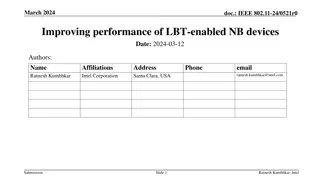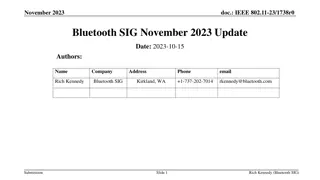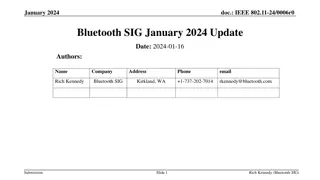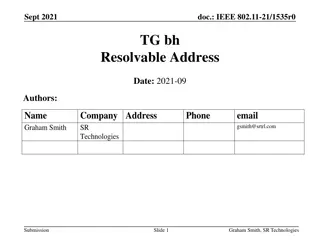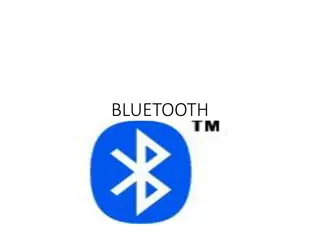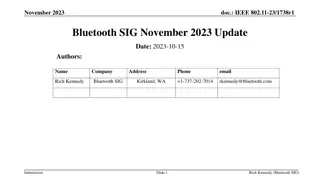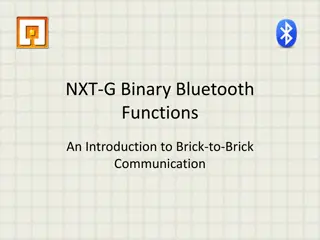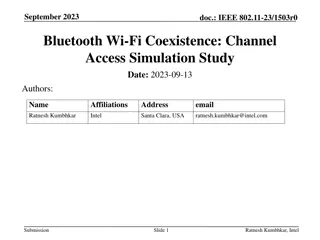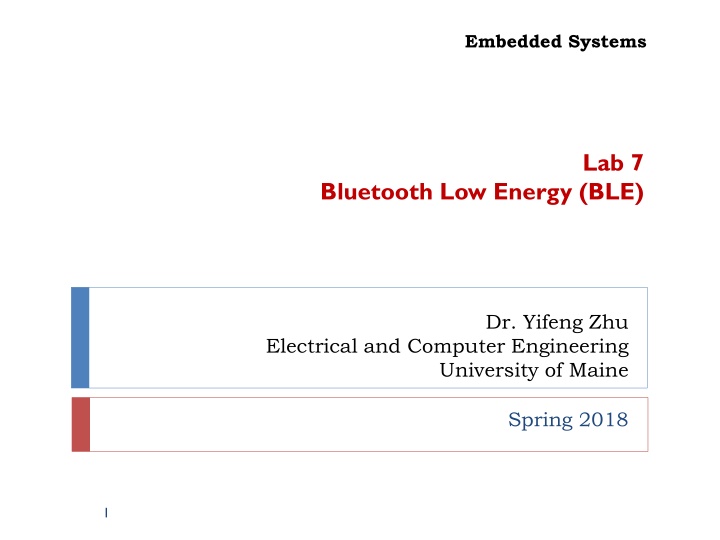
Bluetooth Low Energy (BLE) Technology and Protocols
Explore the key details of BLE technology, including power consumption, simultaneous connections, transmission details, protocol stack, and profiles such as GAP, GATT, ATT, SM, and L2CAP.
Download Presentation

Please find below an Image/Link to download the presentation.
The content on the website is provided AS IS for your information and personal use only. It may not be sold, licensed, or shared on other websites without obtaining consent from the author. If you encounter any issues during the download, it is possible that the publisher has removed the file from their server.
You are allowed to download the files provided on this website for personal or commercial use, subject to the condition that they are used lawfully. All files are the property of their respective owners.
The content on the website is provided AS IS for your information and personal use only. It may not be sold, licensed, or shared on other websites without obtaining consent from the author.
E N D
Presentation Transcript
Embedded Systems Lab 7 Bluetooth Low Energy (BLE) Dr. Yifeng Zhu Electrical and Computer Engineering University of Maine Spring 2018 1
Bluetooth Classic vs Bluetooth Low Energy Power Consumption Bluetooth classic has a higher power consumption due to a higher data rate Applications Bluetooth classic can stream data and BLE is best for periodic transfer of data Simultaneous connections BLE can establish up to 20 connections, Bluetooth classic can only have 7 connections. 2
BLE Details BLE transmits at 1Mbps Has a range of 2 to 5 meters BLE operates in the 2.4GHz 2.48GHz range also known as the industrial, scientific, and medical (ISM) spectrum. Streaming not available for BLE 4.1 so all data is sent via data packets Data stored little endian format 3
Generic Access Profile (GAP) GAP is in controls of advertising and connections. This layer specifies how devices perform control procedures such as device discovery, connection. Helps maintain a consistent and interoperable communication 5
Generic Attribute Profile(GATT) Defines how data is organized and exchanged between different applications. Defines the way that services, characteristics, and descriptors can be defined and used. Built on top of the ATT and SM 6
Attribute Protocol (ATT) This allows the device to say what certain pieces of data are. Each piece of data has an attribute type saying what it is and is defined by a 16 bit universally unique identifier (UUID). An example of an attribute is shown below Attribute handle Attribute type Attribute Value Attribute permissions 0x008 Battery voltage UUID Battery Voltage Value Read only, No authorization, No authentication 7
Security Manager(SM) Bluetooth low energy link layer supports encryption and authentication. 8
Logical Link Control and Adaptation Protocol (L2CAP) Takes multiple protocols and encapsulates them into the standard BLE packet format. Takes long bits of data and separates them into the 37 bytes maximum payload size for BLE for transmit and vise versa for receive. In charge of routing the ATT and SM 9
Host Controller Interface(HCI) Host and Controller Side The host communicates via a serial interface SPI, UART, etc. To the HCI on the controller side. Most of the HCI comes from Bluetooth low energy specifications. On the controller side it can pull a line high signaling that it has a received a packet and will transmit it to the microcontroller. 10
Link Layer (LL) handles packets of data, and interfaces with the physical layer, and in charge of establishing connections. Information is exchanged via packets, No streaming is available Advertising packets are used for find and connect to other devices or to broadcast data. Channels 37, 38 39. Data Packets are used once a connection has been bade is established by master and slave. Channels 0 -36. The table below shows the Packet structure Bits 8 32 8 8 0-296 (37 Bytes) 24 Contents Preamble Access Address Header Length Data CRC 11
Physical Layer(PHY) Contains the analog communications circuity used for modulating and demodulating analog signals and transforming them into digital symbols. 12
Channels Blue Advertising Packets Red Data Packets Type 37 0 1 2 3 4 5 6 7 8 9 10 38 11 12 13 14 15 16 17 18119 20 22 23 24 25 26 27 28 29 30 31 32 33 34 35 36 39 Channel Frequency 2402MHz 2404MHz 2408MHz 2410MHz 2412MHz 2414MHz 2416MHz 2418MHz 2420MHz 2422MHz 2424MHz 2426MHz 2428MHz 2430MHz 2432MHz 2434MHz 2436MHz 2438MHz 2440MHz 2442MHz 2444MHz 2446MHz 2448MHz 2450MHz 2452MHz 2454MHz 2456MHz 2458MHz 2460MHz 2462MHz 2464MHz 2466MHz 2468MHz 2470MHz 2472MHz 2474MHz 2476MHz 2478MHz 2480MHz 14
ST Bluetooth Drivers Application Control Interface (ACI) replaces some of the HCI while implementing GATT, ATT, SM, and L2CAP. This makes programming very easy using ACI commands that take care of HCI, GATT, ATT, SM, and L2CAP 15
Basic ACI functions aci_hal_write_config_data sets up the public address aci_gatt_init - initializes the GATT aci_gap_init_IDB05A1 initializes the GAP aci_gap_set_auth_requirement GAP sets up authentication where you can change the pin/password for the device aci_hal_set_tx_power_level - Set output power level Add_ConfigW2ST_Service/Add_ConsoleW2ST_Service/Add_HWServW2ST_Servic e Setup and initialize the different services name and UUID that data is going to be exchanged through aci_gatt_update_char_value used to update data sent via Bluetooth, all data is associated with a handle that tells it which service and UUID to send it with. 16






